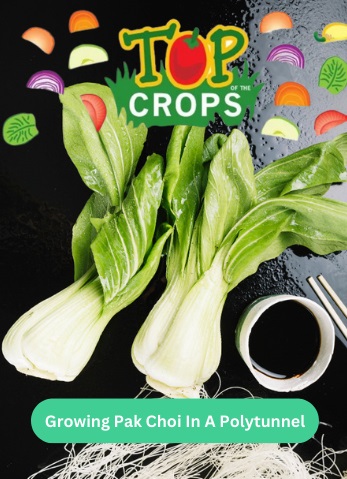Pak choi, also known as bok choy (or Chinese cabbage) is a world renowned leafy green plant which has graced our plates for centuries, especially in Asian culinary traditions. This vibrant vegetable doesn’t just bring a delightful crunch to recipes and dishes; it’s a powerhouse of nutrition, brimming with essential vitamins and minerals that aid our health. In this article, you will learn how to grow pak choi, from seed to harvest, and how you can have a stress-free experience for growing this plant in the UK.
Whilst growing pak choi can be a rewarding experience, you still need to make sure that you have the right knowledge and tools at your disposal to make sure you can get the best optimum results from growing pak choi. Here is a checklist of items that you will need:
Follow the table below to know when to plant pak choi, how and when to sow, how to grow, and harvesting pak choi in the UK.
| Jan | Feb | Mar | Apr | May | Jun | Jul | Aug | Sep | Oct | Nov | Dec | |
| Sow |  |
 |
 |
 |
 |
|||||||
| Plant |  |
 |
 |
 |
 |
|||||||
| Harvest |  |
 |
 |
 |
Belonging to the Brassica rapa species within the cabbage family, its cultivation traces back to China around the 5th Century. Its robust nature and straightforward cultivation process have led to its widespread adoption in various cool temperate areas worldwide, including here in the UK.
Pak choi stands out as a highly advantageous vegetable, particularly suitable for novice gardeners due to its simplicity in cultivation, swift maturation, and delightful taste.
Now that you have the necessary equipment ready, you can begin growing your pak choi plant, by following this step-by-step guide!
Prep the soil:
Begin by preparing the soil. If you’re using garden beds, turn the soil to a depth of about 8-10 inches, breaking up any large clods. This ensures a loose and aerated environment for the roots. If your soil is heavy or clayey, consider amending it with organic compost or well-rotted manure to improve drainage.
Location:
Pak choi thrives in locations that receive partial to full sunlight. However, in regions with intense midday sun, a spot with afternoon shade can help too. Ensure the chosen location has good air circulation to prevent fungal issues.
Once your soil is ready, it’s time to sow the seeds.
Pak choi requires consistent moisture for optimal growth. Water the soil thoroughly after planting the seeds. Thereafter, aim to keep the soil consistently moist but not waterlogged. A good rule of thumb is to water when the top inch of soil feels dry to the touch. Using a gentle watering method, like a watering can or soaker hose, prevents soil erosion and ensures even moisture distribution.
This is the most beneficial stage of your growing efforts. Pak choi is ready for harvest when it reaches about 4-6 inches in height, typically 45-60 days after planting. To harvest, use sharp, clean scissors or shears and cut the plant at its base. For more prosperous results, consider staggered plantings every 2 weeks.
If you are harvesting a mature pak choi, you can recognise this by how firm and upright the stalks are, as well as ensuring it has vibrant green leaves. Typically, it reaches a height of 4-6 inches for baby pak choi and 12-18 inches for full-sized varieties. The leaves should be broad, glossy, and free from blemishes, while the stalks should be crisp and white or pale green. Harvesting is ideal just before the plant starts to bolt or produce a flowering stalk.
Growing pak choi can be a delightful endeavour, whether you’re starting from seed or opting for container gardening. Each method has its unique advantages, and understanding them can help you make an informed choice.
Starting pak choi from seed offers a sense of accomplishment that is unbeaten for quality. Seeds are typically more cost-effective and provide a wider variety of cultivars to choose from. For successful germination:
• Ensure the seeds are fresh and sourced from a reputable supplier.
• Plant them at the right depth, typically 1/4 to 1/2 inch, and keep the soil consistently moist.
• A warm environment, around 60-70°F (15-21°C), can boost germination rates, so consider using a heat mat if planting indoors.
Container growing pak choi is best for those with space constraints or challenging soil conditions. It offers flexibility, mobility, and control over the growing environment. Tips for successful container cultivation include:
Despite the relative ease with growing pak choi, you can still experience problems in regards to pests and diseases. However, we have preventative measures to address potential issues that you may face whilst growing pak choi.
Regularly inspecting plants, practising crop rotation, and maintaining clean garden spaces can go a long way in preventing these issues. Additionally, fostering a garden ecosystem with diverse plants can attract beneficial insects that naturally keep pests in check. Companion planting is a very good idea here too, as this will help to deter flea beetles, for example, when paired with radishes.
Growing pak choi in a domestic polytunnel can also be advantageous, since polytunnels act as a protective shield from external weather, whilst also providing pak choi with the warmth that it needs in order to grow. Ideally, aim for a temperature range of 60-70°F (15-21°C) for optimal growth. By harnessing the benefits of a polytunnel and ensuring proper ventilation and temperature control, you can cultivate pak choi that’s both robust and flavourful.
Plus, if you already have your polytunnel set up and ready to go, we also offer a variety of spares & accessories to ensure you can get the optimal usage from your polytunnel. However, you should also be aware of dealing with extreme weather with your polytunnel during all gardening activities.
BBC Good Foods. (2020) Pak Choi Recipes. [online] Available at: https://www.bbcgoodfood.com/recipes/collection/pak-choi-recipes [accessed 21/03/24]
Agrinova Science. (2023) FOLIGREEN 24-12-12 NPK Fertiliser. [online] Available at: https://agri-nova.com/en/product/foliar-fertilizers/foliar_fertilizer_241212/ [accessed 22/05/24]
Thompson & Morgan. (2023). Pak Choi Green F1 Hybrid Seeds. Thompson & Morgan. [online] Available at: https://www.thompson-morgan.com/p/pak-choi-green-f1-hybrid-seeds/268TM [accessed 22/05/24]
Planet Natural. (2023). Downy Mildew. Planet Natural. [online] Available at: https://www.planetnatural.com/pest-problem-solver/plant-disease/downy-mildew/ [accessed 22/05/24]
